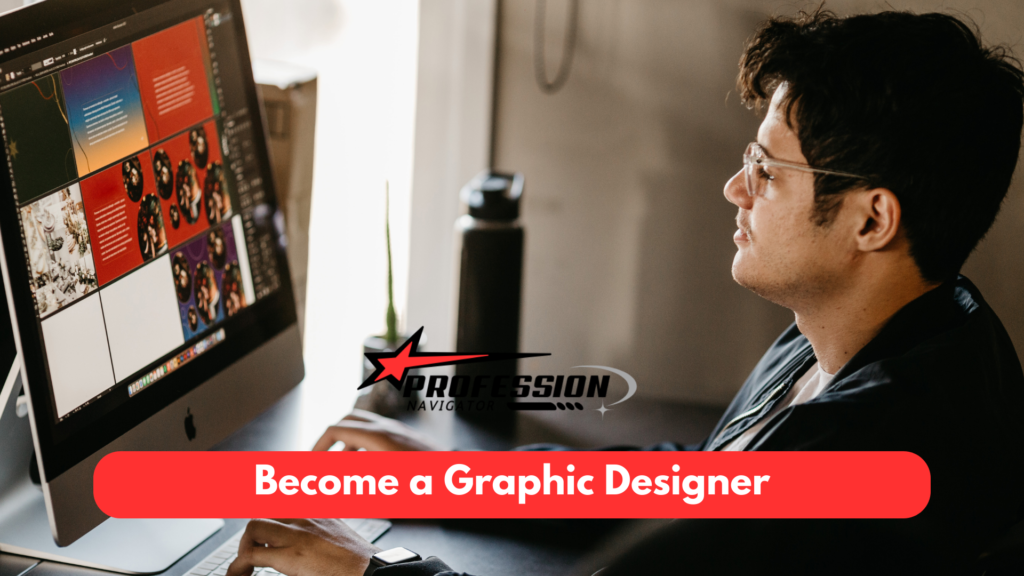Become a Graphic Designer
Become a Graphic Designer: Ever wondered how all those eye-catching logos, sleek websites, and stunning ads are created? That’s the magic of graphic design! It combines visuals, typography, and layout to communicate ideas. If you love to think creatively and solve problems visually, a career in graphic design might be your perfect match. Plus, there’s always a demand for designers, whether it’s for digital platforms, print, or branding. So, let’s dive into what it takes to become a graphic designer!
Table of Contents
What Does a Graphic Designer Do?
Graphic designers are like visual storytellers. They work on a variety of projects, from creating logos and brand identities to designing websites and apps. The main goal? Make sure the visuals not only look good but also communicate a message. You might be designing for a business, a marketing campaign, or even a product launch. Every day is different, and that’s part of what makes it exciting!
Read also: Data analyst
Why Graphic Design is Everywhere
Whether you realize it or not, graphic design is all around us. From the packaging of your favorite snacks to the layout of your favorite app, design plays a key role in making things visually appealing and easy to understand. Industries like marketing, technology, entertainment, and fashion all depend on strong design to build connections with their audience.
The Skills You’ll Need as a Graphic Designer
Mastering Design Tools
To kickstart your career as a graphic designer, you’ll need to get comfortable with a few design tools. Adobe Creative Suite (like Photoshop, Illustrator, and InDesign) is the industry standard, but other options like Figma and Sketch are great for web design and user interfaces. Don’t worry if you’re not familiar with all of them yet—practice makes perfect!
Understanding Typography and Color
Ever wondered why certain designs just “feel right”? It’s often because the designer has a solid understanding of typography and color theory. These are the building blocks of good design. Choosing the right fonts and color schemes can elevate your work and make it more impactful. It’s all about making sure your design is both functional and visually appealing.
Creativity is Key!
At the heart of graphic design is creativity. Clients will come to you with a problem, and it’s your job to create a creative solution. Whether it’s designing a logo or laying out a website, thinking outside the box will help your designs stand out.
Communication and Collaboration
Graphic designers rarely work in isolation. You’ll be collaborating with clients, developers, and other creatives. So, having strong communication skills is super important. You’ll need to understand client feedback, explain your design choices, and make sure everyone’s on the same page.
Do You Need a Degree to Become a Graphic Designer?
The short answer: not always. While some graphic designers have degrees, it’s not a strict requirement. What matters is your portfolio and skills. Employers and clients want to see that you can create great designs, whether you learned through formal education or taught yourself.
Learning on Your Own: Online Courses and Resources
If college isn’t for you, there are plenty of online courses and self-learning resources available. Websites like Udemy, Skillshare, and Coursera offer courses for beginners and pros alike. Plus, platforms like YouTube and Behance are full of free tutorials and inspiration.
Building a Killer Graphic Design Portfolio
Your portfolio is your ticket to landing gigs or a job. It’s like your visual resume, showing off your best work. Make sure to include a variety of projects, from branding to web design, and show your range. Remember, quality over quantity. If you’re just starting, you can include personal projects or redesigns of existing brands.
Finding Your Graphic Design Niche
Branding and Logo Design
If you love helping businesses tell their story visually, branding and logo design might be your thing. You’ll be working on everything from logos to color schemes and typography that define a brand’s identity.
Web and UI/UX Design
For those who enjoy designing interactive experiences, web design or UI/UX design might be the perfect fit. You’ll be focusing on how users interact with websites and apps, making sure they’re not only beautiful but also easy to use.
Illustration and Motion Graphics
Are you a doodler at heart? If so, illustration or motion graphics could be a great niche. Illustrators create custom visuals, while motion graphic designers bring designs to life with animations. It’s all about adding that extra layer of creativity.
Gaining Experience: Internships and Freelancing
Start Small, Think Big
When you’re starting, it’s all about getting experience. Internships and freelance work are perfect ways to get your foot in the door. Internships offer hands-on experience, while freelancing gives you the freedom to work with different clients and build your portfolio.
Networking Matters
Networking is essential in any creative field, and graphic design is no different. Attend design meetups, join online design communities, or even reach out to other designers on platforms like LinkedIn. Building relationships can open doors to opportunities you might not have known about.
Essential Design Tools You Need to Know
Aside from Adobe Creative Suite, there are other tools every designer should be familiar with. Figma, Sketch, and even Canva are becoming increasingly popular in the design world. Staying updated with these tools can help you work more efficiently and keep your skills sharp.
Starting Your Career: What You Need to Know
Landing Your First Job
Ready to kick off your design career? It all starts with applying! Polish your resume, get your portfolio ready, and start applying for entry-level jobs, freelance gigs, or internships. Platforms like Behance, Dribbble, and LinkedIn are great for showcasing your work and connecting with potential clients or employers.
Visit: Latest Graphic Designer jobs in the UK
Freelance vs Full-Time
As a graphic designer, you have the option to work freelance or take on a full-time role. Freelancing offers flexibility and lets you choose the projects you’re passionate about. On the other hand, full-time positions offer stability and benefits. It all depends on your lifestyle and career goals.
Salary and Career Growth as a Graphic Designer
What to Expect Starting Out
Starting, graphic designers can expect to earn around $40,000 to $50,000 a year, depending on where you live and the industry you’re in. Freelancers might charge by the hour or project, with rates varying based on experience.
Climbing the Career Ladder
As you gain more experience, you’ll have more growth opportunities. You can advance to roles like senior designer, or art director, or even start your own design studio. The sky’s the limit!
Conclusion
Becoming a graphic designer is all about combining your creativity with technical skills. Whether you choose formal education or the self-taught route, the key is to practice and build a strong portfolio. Stay curious, keep learning, and don’t be afraid to take on new challenges. There’s no one “right way” to become a designer, so make your path and enjoy the journey!
FAQs
Is graphic design a good career choice in 2024?
Absolutely! Graphic design continues to be in high demand as businesses and brands rely on strong visuals to stand out in a crowded market.
What is the best way to start learning graphic design?
Start with the basics! Learn design principles, play around with Adobe tools or Figma, and take online courses to build your skills.
Do I need coding skills as a graphic designer?
Not necessarily, but it can be helpful, especially if you’re working in web or UI/UX design.
How important is having a portfolio?
Your portfolio is crucial! It’s the best way to showcase your skills and get clients or employers interested in hiring you.
Can I work remotely as a graphic designer?
Yes! Many graphic designers work remotely, especially freelancers. With the right tools and communication, you can work with clients from all over the world.



